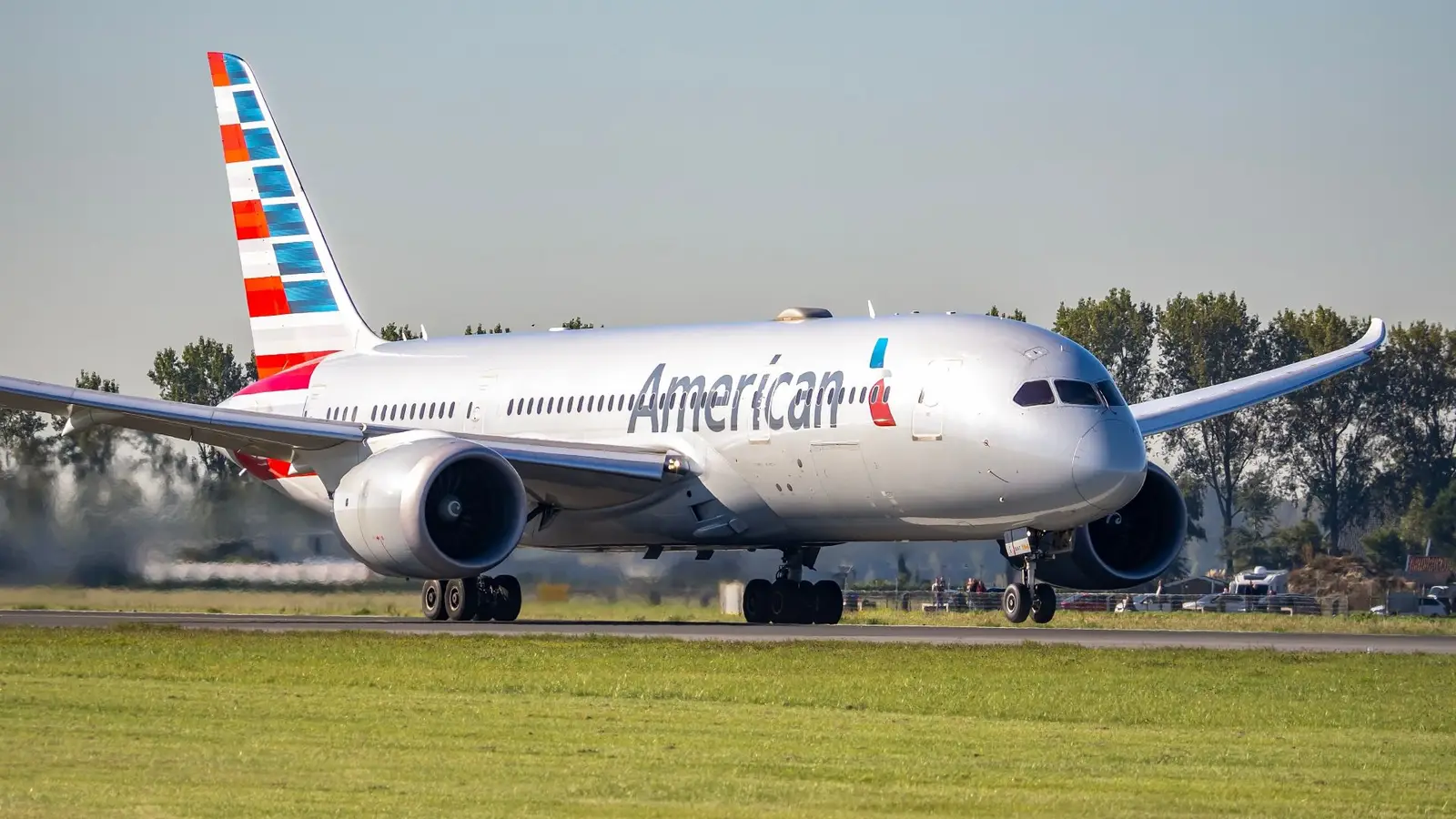
For American Airlines, the Boeing 787 Dreamliner has become the backbone of its international and premium long-haul strategy. Since introducing the type in 2015, American has steadily expanded its 787 fleet to cover key transatlantic, transpacific, and high-yield domestic routes. The Dreamliner’s combination of fuel efficiency, passenger comfort, and range has made it indispensable to the carrier’s ability to compete across continents.
Currently, the 787 fleet is the same size as American’s Boeing 777 fleet (67 aircraft), but this won’t be the case for long. American has 22 Boeing 787-9s on order, and it’s likely that the Dreamliner will be used to replace the carrier’s aging Boeing 777-200ER fleet. As such, the 787 is quickly becoming the carrier’s primary long-haul workhorse. As such, using data from Cirium, an aviation data analytics company, let’s explore the five most in American’s network that see the most Boeing 787s.
Overview Of The American Airlines 787 Fleet
American Airlines operates both the 787-8 and the larger 787-9, with the 787-8 configured for around 234 seats and the 787-9 carrying either 285 passengers or 244. Together, the fleet enables flexibility: with the 787-8 used for thinner routes with lower demand, while the 787-9 is deployed on higher-demand flights. Between the two variants, American covers a wide spectrum of missions, from transatlantic runs to long-haul transpacific sectors.
The Boeing 787-8 flies with 20 business class seats, 28 premium economy seats, and 186 economy seats. Up front in business class, American’s 787-8s come with either the Safran (formerly Zodiac) Concept D, a bespoke herringbone/reverse herringbone seat that alternates between forward and rear facing, while others use the Collins Super Diamond. The Super Diamond is also found on all Boeing 787-9s in the 285-seat layout.
Earlier in 2025, American Airlines began operating a new subfleet of 787-9s internally called the “787-9P”, “789P” or “78P”. Whereas the standard 787-9 configuration features 30 business class seats, 21 premium economy seats, and 234 economy seats, the 787-9P is configured with 51 business class seats, 32 premium economy seats, and 161 economy seats. Additionally, these new planes come with new seats, including the Adient Ascent suites with doors for “Flagship Suites”.
Number Five: Miami To Buenos Aires
While American Airlines has been struggling to match Delta and United in the long-haul arena, the airline remains as strong as ever in Latin America. In large part, this is due to the success of its Miami hub, which is ideally located for connections and has strong local demand. As such, it’s no surprise that one of the top 787 routes in American Airlines’ network is its route from Miami to Buenos Aires, Argentina.
American operates up to three daily flights between these two cities, depending on the season. Typically, only one of these three flights uses the 787 (with the other two flown by the Boeing 777-200ER), although the Dreamliner does take over the second daily flight during some parts of the year. In total, American scheduled 380 flights to use the Boeing 787-8 from Miami to Buenos Aires, and 379 flights coming back throughout 2025.
(Data from aeroLOPA)
Miami International Airport is both a 777 and a 787 base for American Airlines, and as such, American can mix and match a wide variety of aircraft to a particular route. American flies the Boeing 777-200ER, Boeing 777-300ER, Boeing 787-8, and Boeing 787-9 out of Miami, and the airline often finetunes the capacity that it offers to a given destination. This is perfectly seen on the Miami to Buenos Aires route, which sees two daily 787-8s, one daily 787-8 and a 777, or two 777s and a 787-8.
Los Angeles To Tokyo-Haneda
American Airlines is far from the only carrier connecting Tokyo with Los Angeles. Domestically, American faces competition from United Airlines and Delta Air Lines to Haneda, while United flies a second daily flight to Tokyo-Narita. Additionally, All Nippon Airways connects Los Angeles to both Tokyo-Haneda and Tokyo-Narita, while Singapore Airlines operates a fifth freedom route from Los Angeles to Tokyo-Narita that continues to Singapore.
American Airlines operates up to two daily flights between Los Angeles and Tokyo-Haneda, both with the Boeing 787-9. Currently, these fly with the 285-seat layout, as the 78P subfleet is only deployed on a select number of routes. However, Tokyo is one of the largest business markets in Asia and it would not be a surprise to see American eventually switch to the 78P on this route. United, for comparison, flies the 787-9 and 787-10, while Delta flies the Airbus A350-900.
While American flies two of its 787s daily between these two cities, it actually sells tickets on a total of four daily flights. This is because American has a joint venture with Japan Airlines, which flies one 787 between Los Angeles and Tokyo-Narita, along with a 777-300ER between Los Angeles and Tokyo-Haneda. These two airlines coordinate pricing and schedules, meaning that American and JAL act as one across the Pacific.
The Outlier: Miami To Philadelphia
Miami and Philadelphia are both American Airlines hubs, and as such, the carrier moves a huge amount of traffic between the two airports. This is the case with all hub-to-hub routes, but Philadelphia was a former US Airways hub. This means that it took time for American to build traffic between the two airports as it developed its post-merger network. Hub-to-hub routes also allow airlines to profitably fly widebodies between different hubs.
The higher traffic between hubs means that airlines can fill widebodies, but additionally, this allows for better aircraft utilization. American bases the 787 in both Philadelphia and Miami, allowing for Dreamliners to easily operate this route between long-distance flights. American formerly operated Airbus A330 flights from Philadelphia to Charlotte before the COVID-19 pandemic, as both of these cities were A330 bases at the time (American now flies the Boeing 777 out of Charlotte).
In total, American has scheduled 499 Dreamliner flights from Philadelphia to Miami in 2025, and 497 flights from Miami to Philadelphia in 2025. The 787 mainly flies this route during the winter season, when transatlantic demand is lower. Philadelphia is American’s primary transatlantic connecting hub, and sees a significant reduction in flights during the winter. Flying the Dreamliner on this route allows American to use its planes and crews on a route that can easily support the extra capacity.
Philadelphia To London Heathrow Airport
Although Philadelphia was originally a US Airways hub, it’s become one of American’s most important gateways. The airline has a weak presence in New York and has pivoted towards focusing on routes with strong local demand, while Philadelphia is now the connecting hub. London-Heathrow, meanwhile, is American’s transatlantic hub on the opposite end of the Atlantic Ocean, and receives flights from every American hub.
London is undoubtedly Europe’s largest and most influential city. All three US legacy carriers have significant operations to London, but American is unique in that its primary transatlantic joint-venture partner is British Airways. Just as with Japan Airlines, American and British Airways (along with other European oneworld members) act as one, and for all intents and purposes, London-Heathrow is an American Airlines hub.
The Philadelphia to London route sees up to two daily flights, and Cirium data shows that American has scheduled a total of 576 flights to fly between the two cities each way in 2025, all of which are with the 787-9. As of now, these use the 285-seat configuration, but soon switch to the 787-9P as American grows this fleet. Given how many additional premium seats the 787-9P offers, this is the exact type of route that this layout is designed for.
Top Position: Chicago O’Hare To London-Heathrow
No other route in American Airlines’ network sees more Boeing 787 Dreamliners than the route from Chicago-O’Hare to London-Heathrow. American flies up to three 787-9s daily, and has scheduled a total of 933 flights each way between the two cities in 2025. This was the first route to see the 787-9P layout, and American now places this super premium aircraft on all three of its daily flights between the two cities.
On this route, American faces competition against United Airlines, which flies three daily flights using its premium Boeing 767. American Airlines has been struggling in Chicago against United, which has long been the larger airline in the Windy City. By switching to aircraft with more business class seats, this makes American Airlines more competitive.



